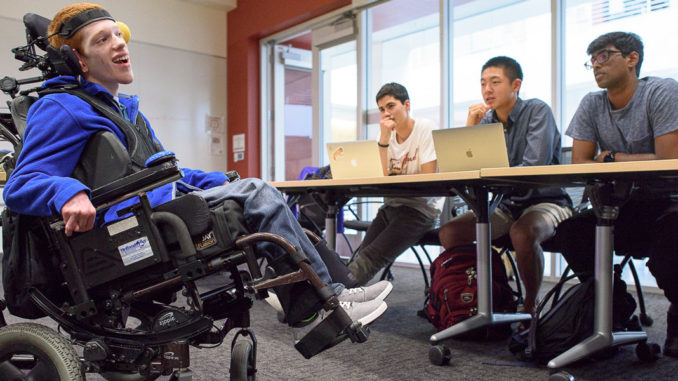
A New Course by Stanford Teaches Designing For People With Disabilities
A new course teaches undergraduates how to design for people with physical disabilities. Each week, students learn about a different disability, then brainstorm design ideas to address issues and present their work to the class.
A new course teaches undergraduates how to design for people with physical disabilities. Each week, students learn about a different disability, then brainstorm design ideas to address issues and present their work to the class.
Students in a new undergraduate course have this question to ponder: How would it feel to be a bright person with big goals and ideas, but live in a world that’s not designed for you?
The new course, called Dare to Care: Compassionate Design, spurs students to consider how to engage and address the needs of a diverse community of people with physical disabilities, and it’s not just for the engineering-minded – freshmen and sophomores from all majors can apply for one of the 16 slots.
The idea for the course has been brewing for some time. John Moalli, a lecturer in chemical engineering, teaches a course called Masters of Disaster, in which student teams analyze disasters and design new products with lessons learned in mind. Last fall, he assigned his class to modify a wheelchair, and the project was a hit. “Students said it was overwhelmingly their favorite project,” Moalli said. “I think they liked the notion that they were helping somebody – they really saw a purpose.”
The wheelchair project was inspired by Moalli’s volunteer work as a high school STEM teacher in his home state of Washington. One of his students, 17-year-old Zach Crighton, has cerebral palsy. Crighton has trouble moving and speaking. “I started to work with him and came to realize that he was super bright, but had no means of self-expression,” Moalli said. “I realized that this boy wasn’t much different from the students I teach at Stanford. How would they feel if they had all the capacity they had but were constrained in Zach’s body?”
A personal connection
At the end of the Masters of Disaster class, Moalli approached his teaching assistant, Danielle Lucas, about creating a design class that addressed disabilities like Crighton’s. Lucas immediately jumped on board, helping brainstorm ideas for the new course. Lucas, a senior majoring in behavior design, plans to teach children with disabilities in Thailand after graduation. Beyond her career goals, she has a personal reason for her involvement with the course: Her brother Justin is disabled.
“My relationship with my brother Justin is hands down one of the most special relationships in my life,” Lucas said. “Justin has taught me more about compassion and understanding than anyone, and growing up with him has inspired me deeply.” She said she hopes that the Dare to Care course will expose students to the disabled community and give them an opportunity to consider ways they can help.
Krishna Teja Gorrepati, a freshman computer science major, wanted to take this class to get a fresh perspective on CS. He noticed some people couldn’t use the technologies he was creating and wanted to address this gap. “This class puts that focus where there hasn’t been much focus in recent times,” Gorrepati said. “I like getting that other perspective at Stanford and making sure that I can help not just my peers and friends, but all sorts of people.”

Firsthand experience
Dare to Care focuses on physical disabilities, including mobility, sight, speech and hearing. Each topic covered in the course includes a guest who will talk specifically about their disability and the issues they face. Having a disabled guest attend class was important to Moalli and Lucas. “For me, it’s hard to teach about a disability without being disabled myself,” Lucas said. She said that inviting people to tell their story also helps give them a voice.
Crighton, the high school student with cerebral palsy, was the first guest visitor to the Dare to Care class. He, his mom and his paraeducator met the inaugural students and outlined some mobility issues he struggles with. Two of the class projects are directly related to issues Crighton faces every day: better head support on his wheelchair, and ideas for improved machine-assisted standing.
Moalli and Lucas’ plan to include guests during class time turned out to be a good one; being able to talk to a disabled person and ask questions resonated with Gorrepati. “When you see an actual person with these problems who can give you feedback about how he feels, it’s a much different experience than having just a bunch of slides that say, ‘These are some of the problems that these people face,’” Gorrepati said. He noted that the in-person interaction and perspective was just as powerful as the ability to learn how to solve these problems.
Moalli sees this course as a spark that will grow over time. He wants Stanford students to think about opportunities to work in this field, to address issues facing people with disabilities. “There’s a great sense of entrepreneurship at Stanford,” he said. “I want to see students go out and start companies and develop technology.”
For students like Gorrepati, the spark has already ignited. He’s already thinking about making future technologies more accessible from the start. “Many of those things cannot be done as an afterthought – they have to be implemented at the beginning.”
As Moalli likes to say, “Which student here will change the world?”
Media Contacts
Amy Adams, Stanford News Service: (650) 796-3695, amyadams@stanford.edu







Leave a Reply